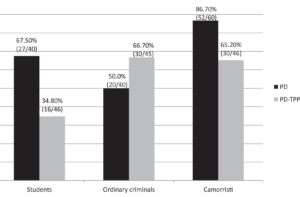Introduction
As we have seen in class, prisoner dilemmas present a situation were working in ones own self-interest appears to be the safer option, but can result in an even worse payoff if both players are using the same rational. However, will players act selfishly when apart of some larger organization, that enforces collaboration for the benefit of the collective. We will analyze the article “Cooperation, punishment and organized crime: a lab-in-the-field experiment in southern Italy”, to determine how mafia members act when placed in such situations.
Experiment Design
In the study, they looked at three groups of people, university students, regular criminals and criminals identified to be apart of the same organized crime group (Camorra Mafia). The focus of the study is to see how cooperative organized crime members were in comparison to the other groups through a prisoners dilemma experiment.
The prisoners dilemma was set up where a subject A would be paired anonymously with a subject B from the same group as them. Subject A and B would each privately, individually and simultaneously decide to gift 10 tokens to the other subject or keep them. If the subject chose to gift their tokens, they would be aware that that gift would triple in value to 30 tokens. So if subject A gifts their 10 tokens to B, B would get 30 tokens instead. Below is the payoff matrix for the combination of choices for A and B, where the payoff is the number of tokens they would have at the end. Once the experiment was over, the subjects could exchange the tokens for real money.
| B | |||
| Keep Tokens | Give Tokens | ||
| A | Keep Tokens | 10, 10 | 40, 0 |
| Give Tokens | 0, 40 | 30, 30 |
For both subjects, keeping one’s tokens is the strictly dominant strategy to ensure they get a payoff. (10, 10) would be the Nash Equilibrium of this game, both subjects keeping their tokens, since it is the best response to best response with no incentive to switch to another strategy within the context of the dilemma.
The Results of the Experiment

Percentage of pairs (black bars) who collaborated (both members gave their tokens).
As one can see in the results, the percentage of pairs who collaborated more was significantly higher for the Camorristi (members of the Camorra mafia). This can be contributed to the influence of mafia culture for these Camorra members. Each of these mafia members are socially bound to abide by an honour system that internally punishes defection severely to promote collaboration for the good of the collective (the mafia). In the context of the game, the collective would earn a greater sum of tokens from each pair of mafia subjects than from a subject acting selfishly.
Conclusion
The prisoners dilemma provides great insight on the influence of organized crime groups for member to member collaboration. It would be interesting to see how other organizations, and corporation members behave when faced with similar experiments.
Source:
Annamaria Nese, Niall O’Higgins, Patrizia Sbriglia, Maurizio Scudiero, Cooperation, punishment and organized crime: a lab-in-the-field experiment in southern Italy, European Economic Review, Volume 107, 2018, Pages 86-98, ISSN 0014-2921, https://doi.org/10.1016/j.euroecorev.2018.05.004. (https://www.sciencedirect.com/science/article/pii/S0014292118300825)